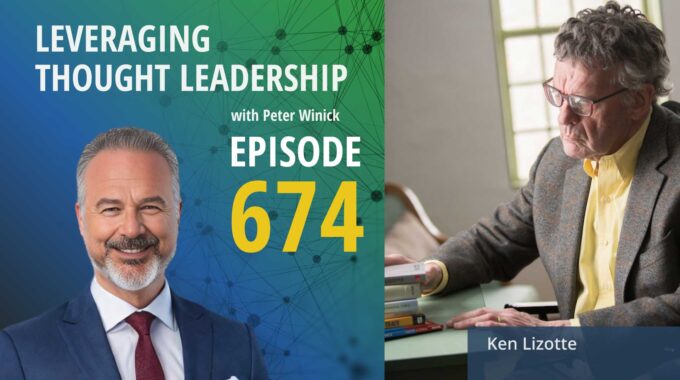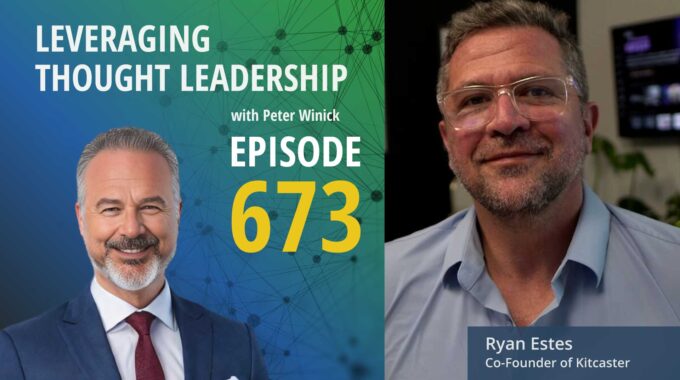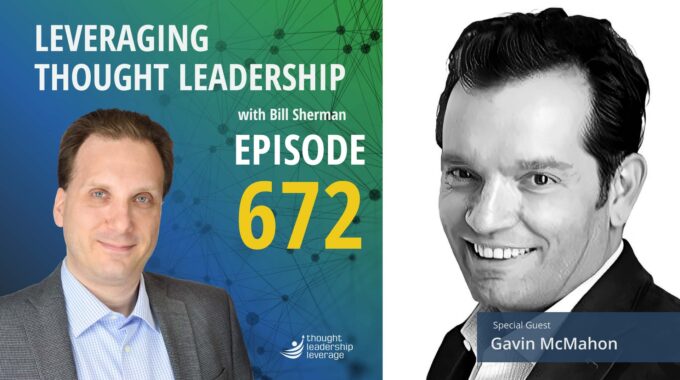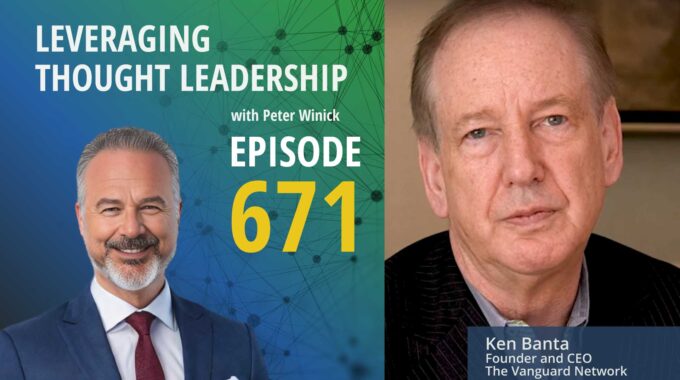Why Great Thought Leaders Don’t Play the Publisher’s Game Peter talks with publishing expert Ken…
Beyond the Keynote: Building a Business Around Your Ideas | Keith Ferrazzi
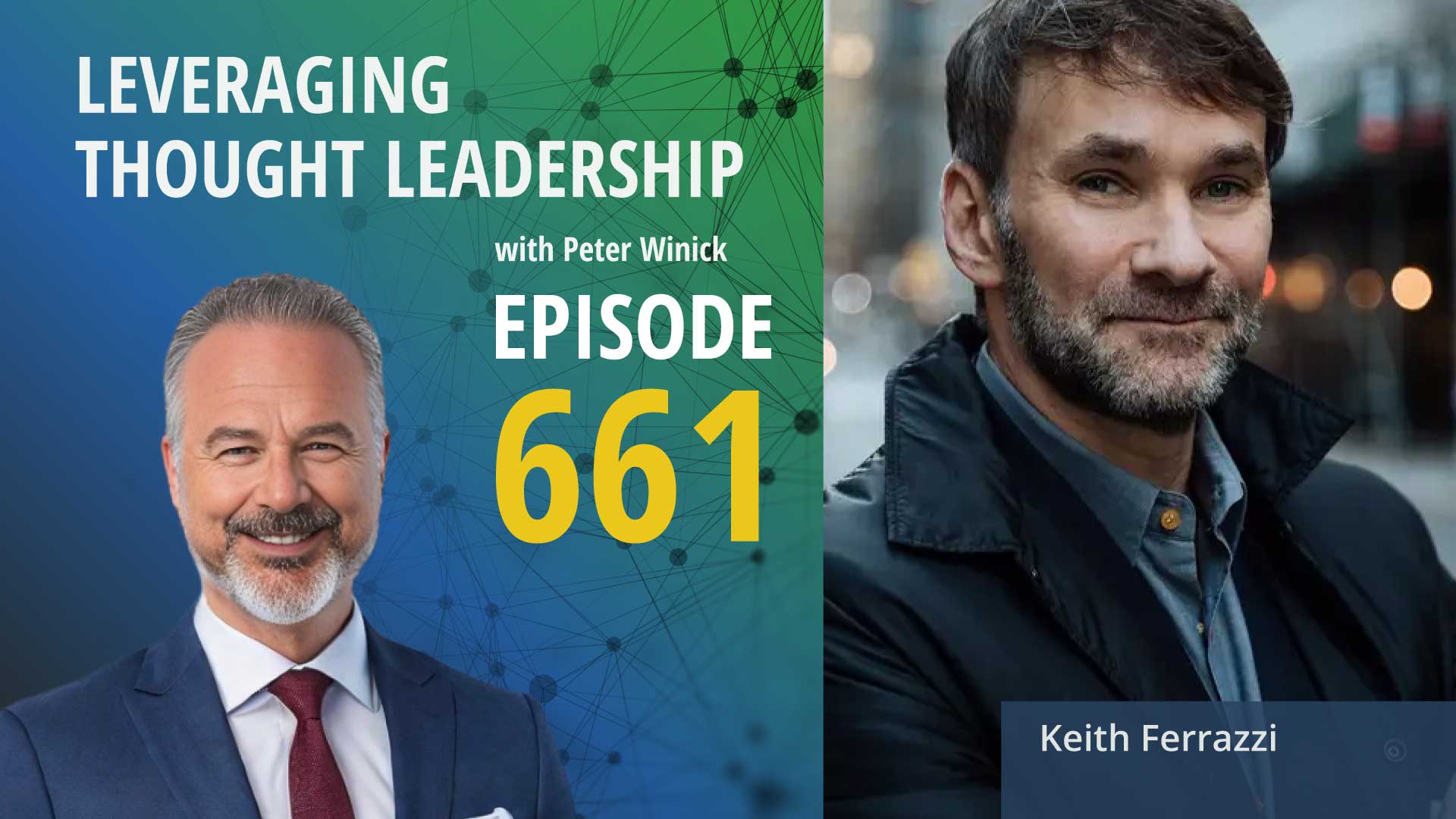
Scaling thought leadership through team transformation
This episode explores how to drive real transformation by empowering teams, not just leaders. Learn why codifying your ideas and using research strategically can turn thought leadership into scalable impact.
What if your team—not just your leaders—held the key to breakthrough performance?
Today, Peter Winick sits down with long-time friend and bestselling author Keith Ferrazzi to explore why “leadership” alone isn’t enough anymore. Keith’s new work, “Never Lead Alone”, moves beyond the
individual and puts the spotlight on “teamship”—a powerful, often-overlooked force in organizational transformation.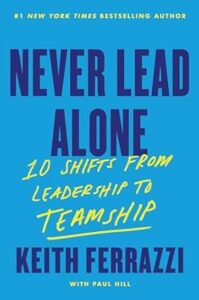
Keith shares how he’s evolved from “Never Eat Alone”—a networking classic—into building high-performing teams inside Fortune 500 companies. But this isn’t just about motivation. It’s about methodology. Codified insights. Research-backed models. Keith reveals how he helps leaders double market cap by engineering behavior change at the team level, not just at the top.
You’ll learn why methodology beats storytelling, why collaboration is the new leadership, and how research—done with clients—can be both a content engine and a revenue stream. Keith also outlines how aspiring thought leaders can start by defining ten transformational takeaways, then refine and test them before writing a word.
This episode isn’t just for authors or coaches. It’s for anyone serious about scaling their thought leadership into real impact. Whether you’re inside a $200B company or building your brand, Keith shows you how to package your ideas to create change—and monetize it.
Three Key Takeaways
Teamship Over Leadership
Keith introduces the concept of teamship—a shift from individual leadership to empowering entire teams to take ownership of outcomes. He argues that in today’s complex environments, real transformation happens when everyone on the team steps up, not just the person at the top.
Codify Your Methodology
Keith stresses that great thought leadership isn’t just about storytelling—it’s about creating repeatable, scalable systems. He encourages aspiring thought leaders to start by defining ten transformational takeaways and building their intellectual property around those core ideas.
Use Research as a Revenue
Engine Rather than treating research as a cost center, Keith explains how he partners with organizations to co-create studies that drive both insight and income. This approach not only funds his work but creates built-in audiences and credibility before a book or product even launches.
If Keith Ferrazzi’s insights on teamship and codifying leadership resonated with you, don’t miss our episode with Julie Williamson. Julie takes a deep dive into how aligned communication and leadership
strategy can unlock the full potential of your teams—echoing Keith’s core message that transformation isn’t a solo act. Where Keith challenges leaders to move from authority to collaboration, Julie shows you how to create that alignment across teams to drive real results.
Listen to both episodes and walk away with a clearer understanding of how to lead through teams, build scalable methodologies, and create impact across an entire organization.
Transcript
Peter Winick And welcome, welcome, this is Peter Winick. I’m the founder and CEO at Thought Leadership Leverage. And you’re joining us on the LinkedIn live version of the podcast, which is Leveraging Thought Leadership. Today’s gonna be a lot of fun because I’ve got a dear old friend, Keith Ferazzi, joining me today. Keith is the author of many, many books, going back from Never Eat Alone to now Never Lead Alone. And he and I worked very closely together for quite some time when we had different hairlines way back when.
Keith Ferrazzi So what, some of us are holding on to ours a little better, but that’s okay. It’s a, it’s a struggling fight.
Peter Winick Yeah, I’d call it a push, but yeah, anyway. Okay, I’m an optimist. So let me start with, you know, we’re going to get to the book in a moment, but you’ve been in the business of thought leadership for coming on 20 years now. Like most thought leaders, this wasn’t the plan, right? You didn’t decide as an undergrad, I’m gonna be a thought leader. You know, most people, most kids wanna be an ass crowd or a firefighter. Nobody really wants to be a though leader against an MBA and thought leader, and then things happen. So for you, it was never read along with sort of the jump into the pool. So maybe tell a little bit of the origin story and then let’s get into sort of what’s different today in the world of, in the business of thought leadership and what’s the same.
Keith Ferrazzi Well, first of all, I… I would beg to differ just a little bit. I always wanted to be an academic. I always really thought that someday I would, I would write a book. I just had no idea that that book would be about networking. You know, I, I was a marketer as groomed at Deloitte and Starwood hotels as the chief marketing officer over there. And I always assumed that my work would be in that space. When Never Eat Alone came along, it was, you know, sort of thrust upon me. Because somebody asked me to write a book about how I was able to achieve a lot of success early. And the first thing I would say is, I do think it’s very important to think in methodology. My early jobs were in the industrial engineering space in manufacturing, down doing total quality management at the front line in manufacturing. And so I’ve always thought as an engineer, When I put my mind to this book about, Keith, why are you successful? I came up with 10 critical tips. And when I’m advising folks today to come up with their own thought leadership, I say it’s not a daunting practice. Start with the 10 sentences that define the takeaways of the book you want to write. And when I say the takeaways, define the ten things that people will walk away from. Your book, feeling deeply grateful and you will be significantly generous to them. And so that’s basically the structure.
Peter Winick What’s beautiful about that structure is, you know, there’s one bucket of thought leaders or speakers or call them what you will, that are really fascinating and entertaining and have wonderful life stories. And they won, you know, Olympic gold medals or survive this or survive that not, not to diminish the stories, but it’s not replicatable or isn’t a system or a method or a process or language definitions, you know, go back to Covey with seven habits. Like we all need a system and process to follow. Now, it doesn’t mean that. You know, if Joe, the actuary reads never read alone, they’re going to turn into Keith Ferrazzi overnight, but they can follow a methodology and develop those capabilities. Well, that’s what I basically say.
Keith Ferrazzi Is everybody has to be able to codify their insights in methodology. So I’m working with a CEO right now that’s a $200 billion company and they’re looking to double the market cap. So two to 400 billion. Obviously there’s a lot of solution engineering that goes into that. And our particular focus on all of this is how do they marshal high performing teams to achieve that So that’s what I do for a living. I coach teams But in the point of this particular person, I keep saying to him, “You think in different ways than other business executives.” The audacity of doubling your market cap over a $200 billion base is extraordinary. So I keep trying to tease out of him, and by the way, this isn’t just for the world of a book someday to make him the next Jack Welch, I’m not in the business that you’re in. I’m trying to get him to codify his methodology for the company. So that people can follow as you begin to think about re-engineering the corporation and changing it from a 200 billion to a $400 billion value, what’s the methodology? What’s the levers you’re pulling? What’s your critical steps? So I do think that any business leader needs to think in methodology from a communication perspective so that people could follow the strategy. Because strategy is one thing, vision is one, but the steps to get there are really about practices and that’s really methodology.
Peter Winick So I want to go to never alone comes out. It’s almost 20 years ago, right? And you had a business, but now sort of a change is everything, right. And the business of thought leadership in those days was primarily perceived to be go out and do a keynote and then do another keynote and do another key note and people are going to love you and buy more books, publish a book every two years. That’s kind of not the way it works today. So talk about sort of the evolution of your business. And then underneath that the importance the increased importance of research. Cause I would argue that a lot of business books, 15, 20, 20 some odd years ago, it could be the Jack Welch way. Like who wouldn’t want to hear how Jack Weltsch got to be Jack Welsch. But the underlying research wasn’t necessarily the prereq that it is today in some level.
Keith Ferrazzi So, the first thing I would say is, I was a chief marketing officer of big companies, Deloitte, Starwood, Head of Sales, and then I moved over to be an entrepreneur working for one of Michael Milken’s companies as a CEO. That is when I was asked to write the book, Never Eat Alone. The book did not come out, though, until after I had already decided that after we had exited that business, I had already decided to start my own firm. And my firm was not about networking. It wasn’t about never get alone. It was about how sales and marketing needed to work more effectively together to, to build bridges in go-to-market strategies. So in the back of my head, I really already had the model of never lead alone as my focus. And then all of a sudden this thing comes out of the blue, never eat alone. And I have to admit, I don’t think I’ve, I don’t ever really back in the day. Lynched on to this asset that I had. This massive successful book and make it congruent with my core business, which is coaching teams. So there were these two platforms I had, there was the consumer version of me, right now you’re alone, who’s got your back, et cetera. And then I started to realize that I needed to make sure that my thought leadership was congruent and supported my core, which is high performing teams, that’s when I started researching. Leading without authority, which was the application, right? Networks from a leadership perspective and, and along the way, you’re right. I mean, I realized that as an academic mind, as an engineering mind, I didn’t want to just riff the most, the most horrific things that we do in publishing is when somebody has a successful book that they took a lifetime to think about and write, then all of a sudden they want you to write your next book in a year and say, what the hell else do I have to say? That was the problem with. Leading Never Eat Alone, and Who’s Got Your Back? I started a research institute, and that has been very important for me for a couple of things. Number one, the recognition that I am not just a one-trick pony. I do not just have a life story, but I have a codified body of knowledge that I am moving forward. What I have done, which I think is different than a lot of people, is my research institute ended up being not only a break-even, but a funding arm for me. Because I did it in partnerships with brands. So when I was writing books like even Who’s Got Your Back, I partnered with the University of Phoenix to not only bring the book to market to their students, but to do a massive tour. And at the same time, the research underpinning how do small groups of people commit to not letting each other fail, that was something that they funded. Because they wanted to bring that to their student body. They wanted to bring it to their alumni network. So along the way, I started building brand relationships in the research, which ultimately helped me even take the books to market, right, because of those relationships. So, you know, Merrill Lynch was a great story and a research that was told in Leading Without Authority, and then it was also a channel strategy for getting the book to market once the book came out. And that’s certainly what I’ve done. With Never Lead Alone.
Peter Winick Just stay here for a minute because I very much love that thinking. And a lot of times when I’m working with clients, people tend to think in a linear way. So I’m going to write a book or here’s the process. I have a, then I’m gonna do the marketing. Well, yeah, there’s that. I’m no, but I have an idea. I have hypothesis. Then I’m to research it. Then I’ll write it, you know, then it’s going to get published. And then there’s the rainbows and unicorns, right? Like, Oh, and then magic will happen. Well, magic doesn’t always happen. And I believe that you can conflate during the research phase. Who else can you interface with during the writing phase? Well, that’s what I’m saying. Marketing.
Keith Ferrazzi Doesn’t come at you, you have to engineer the buyers of the book. Look, you and I both know, and I end up, by the way, I’ve stopped worrying about the bestseller lists. One benefit is I’ve got a number one New York Times bestselling title and nobody credits me for it. Like literally I will be constantly introduced. I made stages and it’s like Keith Frazi, bestselling author. A bestselling author is something that anybody can have because people will claim that they are a cultural team, blah, blah blah on Amazon bestseller for a day. Now they call themselves a bestselling offer.
Peter Winick The reality, I would add you also did that organically because there’s plenty of people that buy their way onto all these lists. I don’t want to even go down that rabbit hole. But the reality is the goal should not be to be a bestselling author. It’s an outcome of.
Keith Ferrazzi Well, I know all I have to say is having being a number one year times bestselling author, it’s not made a difference. It’s, I don’t think it’s ever brought me a dollar for the revenue in my entire life. And I don’t t know that, you know, maybe in credibility sake, but nobody ever remembers to say it, they always just say bestselling author.
Peter Winick All right, so New York Times is listening. Update the Ferrazzi obituary. Let’s put that in there. Yes, please. The one New York time is bestselling author. We want, we want, uh,
Keith Ferrazzi you can tell it’s a bit of a soft spot because, you know, I worked my ass off to be, to be these books and, and because of the success of Never Read Alone, the velocity of interest and who’s got your back was so high that it didn’t, you don’t, it hit hard when it hit. But look, I mean, the thing that I would say is a couple of things to, to those out there. Number one, no question, a research basis is important. Number two, you can actually get other people to fund your research if you co-create with those individuals. And give them a brand lift along the way of what you’re doing. The other thing is, yes, you need to think about your, your sales of the book, the early stage of writing it. And you and I both know that if a book doesn’t, you know, hit 10 to 15,000 in book sales in the first couple of months is if you want to be on the list, it’s got to be in the 1st week, but if If it’s not there in the first couple of months, your book’s gonna have a very short life.
Peter Winick But let’s go to the business side, because there’s a couple of interesting things going on here, right? So the way you make a living, per se, is working with high-impact teams, right, and they’re gonna pay you whatever you wanna charge them because the outcome at that level of leverage is measurable and impactful, right. If you can lift a $200 billion company and be even a small part of getting them to 400 billion, whatever your fees are rounding over in the ground, rounding over, right that’s high touch, right and that requires you to be in the room or in the zoo. Talk a little bit about the, the more leverageable, scalable derivatives of your thought leadership that you get out there. Because part of the focus that I have is, well, how do you democratize thought leadership? Because the more people that touch it, the better it is for everybody. And that there’s a wave that happens from them.
Keith Ferrazzi First of all, one of the things that I am thinking about all the time, the research co-creation is a funding stream. For many people, that funding stream might be quite significant. I plow those earnings back into my research all the time. I just want to be out ahead. You and I talked about this. Calling yourself a thought leader is you know, it’s like And by the way, the problem is everybody is caught up as thinking themselves as thought leaders today. One thing that’s different between when you and I worked together back in the day, 20 years ago is the proliferation of people selling IP. It’s massive today. You right. And so this 20 years, it’s, it’ what you built your business on. Yeah. It’s 20 years of everybody wanting to be a thought leader and viably. So, I mean, one of the chapters in never eat alone. Talks about being an expert, being an expert at something and you can constantly pivot and be an expert at different things on your life is in, in order to stay relevant to what’s going on today. I’m spending most of my time, not just talking about teamship and why teamship is more important than leadership, which I think is a really big idea. But it’s also about how do you apply that in having the C-suite partner differently to get more out of AI. So I just had 120 CIOs and CHROs in New York talking about how to apply this book, Teamship, to the codification of their AI strategies. Because if you do AI in silos, you’re gonna inch forward, but if you it in a collaborative, truly breakthrough way where you bring the best of the engineers of the IT, and CIOs, you bring the people people, you bring business people, and you work differently together, you can 10X it. So I’m always one step ahead of what the Zeitgeist needs.
Peter Winick If you’re enjoying this episode of Leveraging Thought Leadership, please make sure to subscribe. If you’d like to help spread the word about our podcast, please leave a five-star review at ratethispodcast.com forward slash LTL and share it with your friends. We’re available on Apple podcasts and on all major listening apps, as well as at thoughtleadershipleverage.com, forward slash podcast. There a minute because when I when I look at somebody’s body of work, I sort of chunk it into two categories. Here’s what’s evergreen, right? Here’s his here is what will always be true, regardless of the stock market when it’s a recession, who’s in the white house. So again, I’ll use never alone as an example, I still give those books out to people all the time, because there’s some evergreen principles, even though that’s waiting in the days before social media, there’s some goods, really, I wrote it. We rewrote it by the way on
Keith Ferrazzi if you knew that, and we wrote it for the digital era. So Paul and I dusted that off and redid it.
Peter Winick Yep. But so where I was going is so there’s the principles that are sort of evergreen. And then there’s what can you do to connect it to what’s going on in the world today? Exactly. So in your case, you know, what is the C-suite staying up late at night thinking about? What is what is AI? Is it going to attack my business? How do I use it to grow? Where is it? You know, who
Keith Ferrazzi exactly. And so what I’m doing is I’m bringing a methodology to approach that question. Right. So the methodology and people it’s, you know, I, I I’m saddened for people who are one note Johnny’s and you know and by the way, let me say this. Some of those one note Johnny’s do quite well. Yeah. Because it is an evergreen topic. And they just stay focused and that is all they are. And it actually kind of works well for some of them.
Peter Winick Yeah, one, it’s also, they don’t have to have the, the things that you do in terms of the research, right? Cause if you didn’t have the research arm, you probably wouldn’t have much more to say about AI than most other people, right. The research gives you the cutting edge stuff. So you’re taking the, Theoretical and closing the gap to the applied in a way that’s of high value, right, and I mean, years, it’ll be a different thing and you’ll have new research coming up, but it also makes you really relevant to the C suite because they’re again, when you think about. You know, the worst place to be as a thought leader is selling training and development into the HR channel. Yawn, right? Because that’s a commodity. Somebody’s going to do it for a penny less or LinkedIn learning is going to eat your lunch, whatever, whatever the case may be, but having cutting edge content out there, you can charge a premium for that. No, I’ve been, I been very
Keith Ferrazzi surprised and deeply appreciate where anybody can carve out some market at some level. Not everybody is looking to build a global impact brand that changes society and makes tens of millions of dollars. That’s a certain level of aspiration. Sure. Any little bit of what I’m doing. Could make somebody a very good living. Tomorrow morning I’m addressing an audience at coaching.com and what I’m gonna be giving them is a way for any coach and now there are millions of them as we know. Anybody who is in between jobs as a coach used to be that anybody in between jobs was a consultant. Now anybody in-between jobs is a coach. Right. And so I’m going to be giving them a simple methodology in never lead alone on how they can begin to step a team through transformation in a, in a set of high return practices. And I basically give away the coaching manual. I think that’s, you know, for me at this stage of my life, you know, it really is about trying to make the biggest footprint on the planet. I think never eat alone did that. I don’t think. I think the way we talk about networks and networking today was forever changed with that book 20 years ago, and I’m blessed with that on a global basis. Now I’m looking to do the same thing around leadership by focusing on team ship and what is the role of the team? I think we have radically under indexed on what’s the role of the teen in leadership. We focus on leaders and leaders giving good feedback, but we don’t focus on teams and how they give each other feedback. We focus on leaders. And how they hold a team accountable. We don’t focus on how the team holds each other accountable, how the team keeps each other’s energy. So this idea that there’s a layer that’s under curated. And I think that’s important for your listeners who are interested in being thought leaders for themselves. They need to find the white spots. Where are the empty spots? And always be looking for that gap. And I really think that in my world, teamship is a major gap in terms of the leadership genre. No, I think that’s in…
Peter Winick Interesting because we all develop the skills to be good individual contributors or whatever we do marketers accounting, finance, whatever. And then the other thing we want to aspire to be as leaders. But the reality is we’re spending most of our time and most of her working life in teams and we’re not really taught. What is a good team? How can I create the environment and the feedback and the culture of a good thing because without a good team? Hey, you know, we’ve all been on great teams and we’ve been crappy teams, right? And we’re
Keith Ferrazzi And what I find with my diagnostics, and the diagnostics are in the book, and so is the data, the average team is pretty mediocre, meaning on a scale of zero to five, the average team, is a two in terms of its ability to be courageous and speak openly in the room. Yes. Now, if you look at that and you’re trying to double the market cap of a company, there’s no way you can do it with half your team being conflict avoidant. Yeah. Oh. The power of the team is overlooked. HR has spent so much time looking at employee engagement, enterprise equity, and inclusion. What we miss is the work level. Just not focused on how teams get shit done. You can go back 20 years ago and pull off Lencioni’s book, which inspired me greatly and still does, but it is a 20-year-old parable that needs to be updated. You know, the, the modern era of hybrid work, the modern era, of a global marketplace, of American D E and I that still is scrambling to find its foothold and, and for the volatility that exists and the tools that are available today, change teams have changed and it’s
Peter Winick Give me a quick Keith, if you and I were sitting and watching television and the volume was off and a Jenny Craig commercial came on, we would easily deduce, I don’t know, I don’t remember the brand or whatever, but they’re in the business of making large people less large over a period of time. That’s the Jenny Craig before and after. What is the before and the after or what do you aspire the before after to be for folks that are exposed to this work, whether it’s through you personally reading the book, etc. The before.
Keith Ferrazzi And after of never lead alone is a team steps up and has a very clear roadmap on how to step up and what is expected of them to meet the leader in leadership. I sit in a room and the conversation has gone down into a rat hole and I will pause as a coach and say, Hey, raise your hand if you think this has gone into a rattle. Everybody raised their hand. And I’ll say, whose job was it to stop it? And the answer is every once, and you know, how do you get the team to be fully transparent and to meet the leader in the role of leadership? When that happens, the leader gets freed up by 30%. The team steps up and delivers disproportionately more than ever before. And as a result, outcomes are pretty radically transformed. The General Motors organization, I was deeply touched by the CFO when we were working with them. That said this work was crucial to them getting out of bankruptcy, because you can’t have a bunch of silos that aren’t fully pulling together. And I think there’s so much value lost in the interdependencies of business. And that’s always been my point. I mean, originally it was sales and marketing, and I wanted those to be more effective working together in order to drive revenue. And now I wake up and it’s really the whole organization being much more interdependent squeezing value out of the transformation. With AI, it’s necessary. Yeah. You can’t nibble at one part of the value that the sales organization and not get to the R and D commercialization side, which was an end to end process that needs to be re-engineered. Teams, first of all, need to be redefined, having nothing to do with org charts. Right. Workday has is having a big meeting this week. We need to look at redefining teams and redefining feedback and redefine everything outside of an org chart definition. Teams are about who you need to get KPIs done.
Peter Winick Last couple of minutes, address the folks out there that are not as far along in the journey as thought leaders as you are, right? So they’re, they know what their expertise is, they’re trying to figure out what they do with it, whatever. What would you-
Keith Ferrazzi advise, you know, you feel I, not to take them off of your platform. Cause I’m sure you have lots of good library content. Peter Diamandis and I did two really good podcasts. And I’m very proud of one of them was a podcast of how to write a best selling book and the other one was a pod cast of how do you become a world class and have a world-class speaking business and I think go and find both of those. Great. I think they’re, they’re everything that I know. Everything Peter knows about those two topics. But at the core, I would just say to all of you, first thing is get real clear on your five game-changing messages of how you want to change people’s lives. You, you got to define who those people are or they see on your linkers, middle managers, careerists, women, whatever they are, you decide who these people are that you want change their lives, have five statements of the before and the after. Somebody or Jenny Craig, you know, like I want to take them from here to hear, from here, to hear from here. To hear. Once you have that, right. Then you start researching the stories that give it like, then you start the practices that people use. And once you get good on the IP and the other thing is make sure that you’re humble enough to let the world stress test it. When I’m coaching the person to write their book, I’ll say, give me the 10 sentences that would define each chapter of your book. Which is really that X to Y. Each chapter is an X to y. And that’s what this is. This is 10 shifts. You gotta go from leadership to team shift. Each one is a very clear message. And then I would say to them, give those 10 sentences to five of your most thoughtful and courageous candid friends of yours. Write them, eat it up. And then when you do that, then sit and think and rewrite those 10 sentence. Now, when you rewrite them, write a paragraph for each. Then you give it out to those same people and another 10 people. Let them beat the hell out of it. Then come back and rewrite those 10 paragraphs into 10 pages. And once you’ve done that, you’ve got a book proposal.
Peter Winick Cause a lot, a lot of folks think writing a book is as isolated piece. You can’t get there alone because I would rather get the feedback that, you know, three of my sentences were terrible. So I didn’t go down a rabbit hole.
Keith Ferrazzi But it doesn’t understand point one and point four sound exactly the same to the world your nuance makes it make sense that it’s different But in reality, it’s the same thing Where somebody says well, what about this thing? You’re like, oh shit. That’s like entirely different chapter. I didn’t think of You know what? I’ve not written a book yet with generative AI as a partner so well, but what I would do is I would also take every one of those points and Have generative a I write a book about each one. Right. And I would then use that as influence to how you’re writing your chapters. So Generative AI, of course, is your partner in writing today. I don’t think Generative is going to write your book, but Generative needs to be your sparring partner. As you know, then this idea of here’s 10 sentences, just ask of AI to blow out each one, and to… To give me what redundancies it sees, and also can you think of four other sentences congruent to these that I would add?
Peter Winick And there’s… I’m not saying you didn’t say, how would I modify that if I’m talking to an audience of CEOs versus CFO, whatever. And you could say to her, yep, for each one.
Keith Ferrazzi Of my sentences, give me the names of the best thought leaders in that space that I need to go research and read. It’s amazing what generative AI will be as a writing partner, as a thinking partner, that I’ve not had that luxury up to date, and now I’m beginning to do that.
Peter Winick To be mindful of the time, because we had a hard stop about a half hour in. So I thank you for sharing some really great insights as usual.
Keith Ferrazzi And look, I know that so many people have been touched, moved and inspired by Never Eat Alone. I promise you, if you’re an individual that is trying to get the most out of a group of people, that Never Eat Alone will be equally as important to you in the annals of your thought leadership books. So thanks. Awesome! Thank you!
Peter Winick To learn more about Thought Leadership Leverage, please visit our website at thoughtleadershipleverage.com. To reach me directly, feel free to email me at peter at thoughtleadershipleverage.com, and please subscribe to Leveraging Thought Leadership on iTunes or your favorite podcast app to get your weekly episode automatically.


